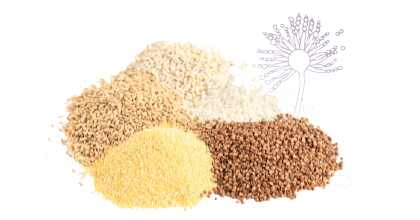With over 15 years of clinical and research experience, Dr. Tassis has made significant contributions to swine medicine and reproduction. He has been actively involved in numerous groundbreaking research projects, particularly in mycotoxin control, the efficacy of feed additives, and the impact of mycotoxins on the reproductive performance of swine. His work has been instrumental in advancing our understanding of how mycotoxins affect livestock health, and performance.

Could you share a little bit about your background and what led you to specialize in swine medicine and reproduction?
My academic journey began in Thessaloniki, Greece, where I studied veterinary medicine and later pursued a PhD focused on mycotoxicosis in breeding stock, specifically sows and boars, and its impact on health and performance.
![]() Since then, we have made substantial strides in addressing critical questions within the field of mycotoxicosis.
Since then, we have made substantial strides in addressing critical questions within the field of mycotoxicosis.
As for what first sparked my interest? Honestly, I am not quite sure.
Despite growing up in the heart of the city, I developed a passion for pigs that seems to have emerged out of nowhere. But from the moment I started, working in this area has brought me immense joy and led to rewarding scientific pursuits across other fields.


You have been involved in various research projects related to the impact of mycotoxins on swine health. What initially drew you to focus on mycotoxins as a research topic?
When I was beginning my studies, one of my late professors shared something that has always stayed with me.
![]() During a conversation about our approach and the work ahead, he mentioned something truly fascinating “mycotoxins can induce almost everything in pigs, yet at the same time, very little.”
During a conversation about our approach and the work ahead, he mentioned something truly fascinating “mycotoxins can induce almost everything in pigs, yet at the same time, very little.”
This insight was like a gift to me, sparking my initial interest in this field.
⇰ It raised questions for me about how to tackle the complexity of mycotoxins and the hidden beauty of studying mycotoxicosis in pigs, whether in vivo or in vitro. And that is how my journey in this area of research began.


Swine reproduction is particularly sensitive to the effects of mycotoxins, such as zearalenone. Based your findings, how do these mycotoxins impact reproductive performance and what strategies have you found most effective in mitigating these effects?
Swine reproduction is the foundation of swine production and, when it goes well, we can then focus on other stages, such as weaning.
![]() Therefore, achieving optimal reproductive balance is crucial and our target parameters must align with the established goals.
Therefore, achieving optimal reproductive balance is crucial and our target parameters must align with the established goals.
However, various mycotoxins can interfere with these targets.
Among the key mycotoxins, we need to address, deoxynivalenol (DON), zearalenone (ZEN), fumonisins (FUM), ochratoxin A (OTA), aflatoxins (AF), and T-2 toxin, with DON and ZEN often being primary concerns due to their impact on swine reproduction.
The toxic effects of these compounds are well-documented, especially regarding reproductive health.
- ⇰ ZEN shows both acute and prolonged effects after long-term ingestion.
- ⇰ DON can impact reproductive aspects, including oocytes, hormonal balances, fetal survival, embryo survival, and boar semen.
- ⇰ Although DON and ZEN are frequent culprits, we must also consider the effects of OTA and FUM on semen or the impact of T-2 toxin on Leydig cells.
![]() We need to remain flexible and keep all major mycotoxins in mind when discussing their effects on reproduction.
We need to remain flexible and keep all major mycotoxins in mind when discussing their effects on reproduction.
Regarding mycotoxin mitigation strategies you requested, I would propose several points that should be kept in mind.
1. Awareness and sourcing
It is essential that farmers, pig producers, and the entire production chain understand the significance of mycotoxins, especially the most predominant ones.
⇰ In this regard, prevention begins with selecting appropriate raw materials, which is a fundamental strategy for mitigation.
2. Sample collection and analysis
Sampling is critical, so it must be done correctly and at the right time.
⇰ Proper laboratory analysis, ideally using LC-MS/ MS techniques, ensures fast and accurate results, allowing us to respond promptly.
3. Mycotoxin detoxification/biotransformation
Selection of the appropriate mitigation, detoxifying, or biotransformation products is key and it should be based on the specific mycotoxins encountered.


Your research on the impact of DON and ZEN, and their modified forms on boar semen in vitro has received considerable attention. What do these findings imply for swine breeding programs and how can producers leverage this information?
Indeed, our research has yielded some very interesting insights. We have conducted a couple of studies on the effects of DON and ZEN on boar semen, both individually and in combination and our findings were significant and eye-opening.
![]() One of our main goals was to establish threshold limits, specifically, the concentration at which these toxins significantly reduce progressive motility in boar semen after one hour of incubation.
One of our main goals was to establish threshold limits, specifically, the concentration at which these toxins significantly reduce progressive motility in boar semen after one hour of incubation.
⇰ We successfully identified this threshold as our first step.
From there, we explored the interactions between these two major mycotoxins, which is one of the most fascinating aspects of mycotoxicosis research.
We examined how DON and ZEN behave together on boar semen in vitro and observed that DON has a slightly different toxic effect than zearalenone’s acute impact on semen. Both mycotoxins, however, negatively impacted various kinetic characteristics.
Interestingly, when combined, the effects on most parameters were less than additive, whereas for some parameters a clear synergistic effect was observed. Notably, we found no antagonistic interactions.
Following this, we studied the effects of DOM-1 and hydrolyzed zearalenone (HZEN) that are generally considered non-toxic.
![]() We wanted to determine if these compounds were indeed non-toxic to boar semen in vitro.
We wanted to determine if these compounds were indeed non-toxic to boar semen in vitro.
⇰ In our trials, we compared the hydrolized products with the parent toxins at equimolar concentrations and demonstrated that they were not harmful to boar semen, supporting their non-toxic classification.


From your perspective, how do you see the occurrence patterns of mycotoxins evolving over the past few years? Have you observed any new trends, particularly in relation to climate change?
Yes, that is very interesting and indeed the million-dollar question.
![]() There are, as we observe in global studies, different patterns of fungal contamination in grains across various regions of the world.
There are, as we observe in global studies, different patterns of fungal contamination in grains across various regions of the world.
Online data reveal these variations clearly, though there are also some consistent findings.
- ⇰ Firstly, mycotoxins are a global issue, present in all regions but showing distinct occurrence patterns depending on the climate.
- ⇰ Secondly, and very significantly, we frequently encounter mycotoxin mixtures in grains, meaning these combinations are also present in the final feed given to pigs.
With the ongoing climate change and warming effects, we see and expect an escalation in these issues.
Published data already indicate that we may encounter higher concentrations and more complex mixtures of mycotoxins, which need to be accurately diagnosed and managed.
![]() This means we should remain vigilant, as warmer, more humid conditions— ideal for fungal growth and mycotoxin production—are becoming more frequent in our daily grain assessments.
This means we should remain vigilant, as warmer, more humid conditions— ideal for fungal growth and mycotoxin production—are becoming more frequent in our daily grain assessments.

You have investigated the use of various feed additives to counteract the adverse effects of mycotoxins. Could you give us an overview of the most promising solutions currently being explored?
Yes, there are various products on the market, and others still in the research stage, which we are continually evaluating for efficacy—a crucial factor for end users in production.
To summarize our findings, we classify these products into two groups.
- ⇰ Adsorbents capable of binding toxins.
- ⇰ Biotransforming products, such as enzymes that can induce biotransformation, for example, of zearalenone into hydrolyzed zearalenone.
In the case of mycotoxin adsorbents, efficacy varies depending on the toxin or toxin mixtures and their interactions.
We have observed effectiveness in vivo, particularly in products that combine adsorbing agents with other components, such as probiotic bacteria or yeast with known mycotoxin-detoxifying properties.
This shift from simple adsorbents to products with mixed compounds, including clays, yeasts, and probiotics, has yielded promising results depending on the toxin involved. As I mentioned…“knowing the enemy is key to selecting the right tool.”
On the other hand, biotransforming products also perform effectively and serve as foundational tools depending on the target mycotoxin in our production processes.


One of your recent studies evaluated the efficacy of a multi-component detoxifying agent against combined exposure of zearalenone and ochratoxin A in weaned piglets. Could you tell us more about the significance of this research and what findings stood out most to you?
Yes, that was indeed another in vivo study and, in this regard, I would like to emphasize the critical importance of conducting in vivo tests for mycotoxin detoxifying products because in vivo conditions differ significantly from those in vitro.
![]() When it comes to mycotoxins, they interact directly with the intestinal epithelium, entering circulation and following distinct metabolic pathways.
When it comes to mycotoxins, they interact directly with the intestinal epithelium, entering circulation and following distinct metabolic pathways.
In the study you mentioned, we worked with four-week-old weaned piglets exposed to combined notable levels of ZEN and OTA, aiming to closely mimic typical on-farm conditions where co-contamination with mycotoxins is common in pig feed.
This six-week study allowed us to observe the animals continuously, monitoring:
- ⇰ Biochemical and hematological parameters.
- ⇰ Performance outcomes.
- ⇰ Residues in liver and kidney (our primary focus in this research).
The product we tested combines a mineral adsorbent with additional agents, such as probiotics, yeast cell walls, and silymarin, creating a detoxifying formula with robust efficacy.
 The data showed a marked reduction in ZEN, particularly its primary metabolite (α-zearalenol) in tissue samples, indicating reduced absorption and distribution, which is precisely the outcome we aim for.
The data showed a marked reduction in ZEN, particularly its primary metabolite (α-zearalenol) in tissue samples, indicating reduced absorption and distribution, which is precisely the outcome we aim for. Additionally, we observed improved feed conversion ratios, likely due to a decrease in zearalenone’s toxic effects.
Additionally, we observed improved feed conversion ratios, likely due to a decrease in zearalenone’s toxic effects. Notably, we also detected indications of liver protection, underscoring the liver’s role in ZEN metabolism.
Notably, we also detected indications of liver protection, underscoring the liver’s role in ZEN metabolism.
READ STUDY


With so many advancements in mycotoxin control and livestock management, what are the biggest challenges that remain unaddressed? Where do you see the need for more research and innovation?
As someone working in both research and academia, I believe that understanding the interaction effects of mycotoxin mixtures — specifically, elucidating the cellular and molecular mechanisms driving changes observed in combined mycotoxicosis cases — is profoundly important to advance our knowledge in the coming years.
This area remains largely unexplored and is crucial for the scientific community to address.
Additionally, biomarkers of exposure represent another critical field.
![]() Increasing our ability to use non-invasive techniques and predictive models to gain precise results from these biomarkers, such as mycotoxin metabolites in samples like urine, feces, blood, hair, or saliva, would provide welfare-friendly diagnostic tools on farms.
Increasing our ability to use non-invasive techniques and predictive models to gain precise results from these biomarkers, such as mycotoxin metabolites in samples like urine, feces, blood, hair, or saliva, would provide welfare-friendly diagnostic tools on farms.
Moreover, novel mitigating and detoxifying products deserve special emphasis, especially those involving multiple compounds, including enzyme-based or biotransforming solutions.
![]() Expanding our toolbox against mycotoxins is vital for supporting swine production.
Expanding our toolbox against mycotoxins is vital for supporting swine production.
Lastly, though challenging and technologically demanding, developing fast and reliable portable diagnostic methods would be invaluable—allowing in situ farm or feed mill testing at a cost-effective rate.
![]() This would enable quicker, more accurate diagnostics and more immediate preventative action.
This would enable quicker, more accurate diagnostics and more immediate preventative action.


Looking ahead, what are your thoughts for the future of mycotoxin research in the swine industry? Are there any emerging technologies or appr
There are some key areas of interest in mycotoxin research, such as emerging and masked mycotoxins, which are increasingly important and gathering greater attention.
Biomarkers are another crucial topic, with techniques to detect mycotoxicosis in the field and on farms swiftly becoming more advanced.
Interactions at the cellular and molecular level are particularly critical, especially concerning the immune response.
![]() The effect of mycotoxin mixtures on the immune response is highly significant, as it has been demonstrated that vaccination efficacy may be compromised.
The effect of mycotoxin mixtures on the immune response is highly significant, as it has been demonstrated that vaccination efficacy may be compromised.
In addition, novel agents, such as biotransforming, adsorbing, or detoxifying agents, could greatly assist farmers and enhance production.
In vivo, studies, which provide insights into the real-world applicability of these novel products, remain essential for improving farm health and combating mycotoxin mixtures.
Advances in laboratory techniques are also paramount, as more cost-effective and rapid detection tests for grains and biological matrices would be highly beneficial.
Research overall continues to expand our understanding of mycotoxin effects and countermeasures. The focus on mycotoxicosis in swine health and reproduction, which began decades ago, persists as a significant research area.
Incorporating new technologies like artificial intelligence or smart monitoring tools could enhance our fight against mycotoxins, providing the scientific community with data that has a direct impact on improving swine health and performance.


On a more personal note, what motivates you the most in your research career?
My motivation stems from the answers and solutions we can provide to primary users within the pig industry overall.
Additionally, working in academia, I find great motivation in passing knowledge to the new generations—future colleagues and veterinarians emerging from our School.
![]() It is rewarding to introduce them to this way of thinking about mycotoxins: the challenges they present, the intriguing nature of the research, and the sense of accomplishment when delivering our findings to the scientific community.
It is rewarding to introduce them to this way of thinking about mycotoxins: the challenges they present, the intriguing nature of the research, and the sense of accomplishment when delivering our findings to the scientific community.





 Micotoxicosis prevention
Micotoxicosis prevention